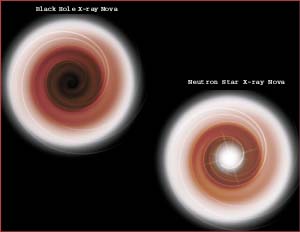Not Seeing is Believing When it Comes to Event Horizon Evidence

Black hole X-ray nova, left, compared to neutron star X-ray nova.
|
NASA's two great observatories, the Hubble Space Telescope and the Chandra X-ray Observatory, have independently provided what could be the best direct evidence yet for the existence of an event horizon, the defining feature of a black hole and one of the most bizarre astrophysical concepts in nature.
An event horizon is the theorized "one-way-ticket" boundary around a black hole from which nothing, not even light, can escape. No object except for a black hole can have an event horizon, so evidence for its existence offers resounding proof of black holes in space.
By using data from Chandra and previous X-ray satellites, a team of researchers studied a dozen "X-ray novae." These are systems that contain a Sun-like star that orbits either a black hole or neutron star. By comparing the energy output from X-ray novae in their inactive, or dormant, phase, the Chandra team determined that the black hole candidates emitted only one percent as much energy as neutron stars.
"It's a bit odd to say we've discovered something by seeing almost nothing, but, in essence, this is what we have done" said Michael Garcia of the Harvard-Smithsonian Center for Astrophysics in Cambridge, Massachusetts. "By detecting very little energy from these black hole candidates, we have new proof that event horizons exist."
If a collapsed star is a neutron star with a solid surface, energy must be released when infalling material strikes that surface. In contrast, if the accreting object is a black hole, only a small amount of energy can escape before it crosses the event horizon and vanishes forever.
"Seeing just this tiny amount of energy escape from the black hole sources is like sitting upstream watching water seemingly disappear over the edge," said Ramesh Narayan also of the Chandra team. "The most straightforward explanation for our observations is that these objects have event horizons and, therefore, are black holes."
Scientists using the Hubble Space Telescope took an entirely different approach. Joseph F. Dolan, of NASA's Goddard Space Flight Center in Greenbelt, Maryland, observed pulses of ultraviolet light from clumps of hot gas that fade and then disappear as they swirled around a massive, compact object called Cygnus XR-1.
Dolan, measuring fluctuations in ultraviolet light from gas trapped in orbit and around the black hole found two examples of a so-called "dying pulse train." This is the rapidly decaying, precisely sequential flashes of light from a hot blob of gas spiraling into the black hole. Without an event horizon, the blob of gas would have brightened as it crashed onto the surface of the accreting body. One event had six decaying pulses; the other had seven pulses. The results are consistent with what astronomers would expect to see if matter were really falling into a black hole, Dolan said.
Chandra researchers used the Advanced CCD Imaging Spectrometer for exposure times that vary roughly from 10,000 to 40,000 seconds per object. Hubble's high-speed photometer sampled light at the rate of 100,000 measurements per second, during three separate Hubble orbits, executed in June, July, and August of 1992.
Additional Links
 Visit the Chandra Observatory (http://chandra.harvard.edu/) home page. Visit the Chandra Observatory (http://chandra.harvard.edu/) home page.
| 